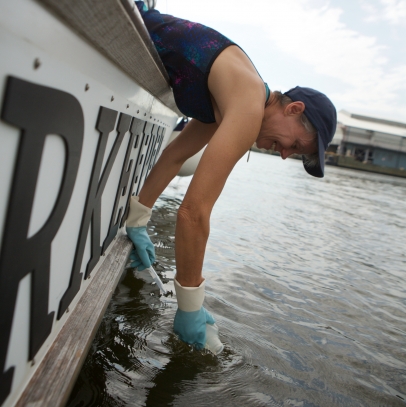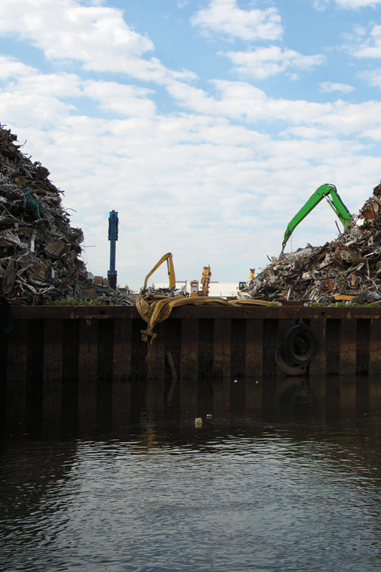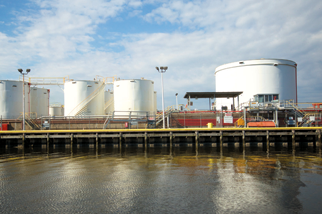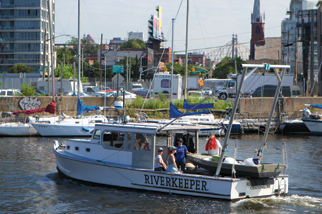Cleaning Up Newtown Creek
New-town Creek,” those well-acquainted with the waterway repeatedly correct the unfamiliar. Many pronounce the 3.8-mile creek’s name like the Nabisco fig treat: “Newton.” The creek divides Queens and Brooklyn, bordering Long Island City, Sunnyside and Maspeth along the way. Newtown is toxic, a designated Superfund site.
This common “Newton” mispronunciation reflects the omission of a central inlet from the collective awareness of New Yorkers.
I spent one spring morning patrolling Newtown with Riverkeeper, an independent organization that improves, restores and protects the Hudson River and its tributaries. Captain John Lipscomb, an affable mariner in a baseball cap, drives the R. Ian Fletcher, a 36-foot repurposed lobster boat, eastward. Patrols allow Riverkeeper to collect water samples and to visibly gauge the state of the creek.
The Empire State Building is visible behind us through the mouth of Newtown and across the East River. Plastic bags and soda bottles, now long forgotten, float in the water ahead.
Despite the waterway’s prime location, its mysteries seem stranger than fiction. The Buckeye Pipeline, an interstate conduit that delivers fuel to JFK and LaGuardia, has a discrete access point at the creek’s shores. For some, boats docked at Newtown’s north end serve as questionably legal homes. And, despite the creek’s toxic state, researchers recently spotted edible species like eel, blue crab, shrimp, oysters and mussels. On land, wild garlic, carrots, chicory, clover and dandelions grow. Although no one can safely consume what swims in or sprouts along the creek today, if remediation efforts continue, locals might one day feast on Newtown Creek’s bounty.
These tensions between industry and nature, necessity and neglect, contaminated and edible, define the dialogue surrounding Newtown Creek. At one time, the low-lying marshland on the inlet’s perimeter brimmed with striped bass, flounder, Atlantic menhaden (a type of herring), and shellfish. Native Americans and, later, Dutch and English settlers cultivated its shores.
The 1800s brought the industry that still exists today. Most significantly, Standard Oil (responsible for a 17- to 30-million-gallon oil spill in 1950 that still leaks into the water) and waste treatment plants, like the Greenpoint Marine Transfer Station, established outposts. Yet, throughout industrialization, Newtown stayed connected to food. Canneries and a sugar refinery set up shop along the creek’s banks. Nowadays, Transmitter Brewing and a Fresh Direct warehouse lie steps away.
At points along Newtown’s surface, what looks like boiling water furiously bubbles up from below. The froth marks the EPA’s aeration system, intended to increase oxygen levels for fish survival. Groups like Riverkeeper and the Newtown Creek Alliance (NCA), a community organization that focuses on the creek’s remediation, question the project’s efficacy. They’re concerned about reliance on a mechanical solution and potential health hazards, among other risks. The EPA spent $115 million on the aeration that merely treats symptoms, instead of the cause.
NCA’s program manager Willis Elkins, a young, soft-spoken artist, also fears ongoing pollution. Elkins says that over a billion gallons of combined sewage discharge into the creek every year from combined sewer outflows (CSOs).
“It’s not a well-flushed waterway, so the conditions are stagnant and the impacts of dumping sewage are amplified.”
Yet few are aware of the creek, never mind its challenges. The public access issue cannot be overstated. According to Sean Dixon, a state attorney who focuses on Riverkeeper’s New York City waterways, industry placement along the banks creates, “a real physical disconnect between the community there and the water. The waterfront edge on the Queens side is inaccessible.” In order for that to change, people must first care.
This separation is conspicuous aboard the Fletcher. Graffitied bulkheads and rusting metal factories loom. Although traces of humanity’s impact are present, I don’t see a soul.
Just as the challenges are intricate—encompassing industry, continued pollution and the lack of public access—so too is the matter of pinning down responsible parties. Dixon says when it comes to addressing those at fault for Newtown’s toxicity, “there are so many cooks in the kitchen. There’s no strategic plan for the creek, for those areas to unify or engage them, or [to] create pockets of any changing use or to create and structure how and where we start with the restoration of the creek.”
One might be quick to argue that industry is the bad guy. Yet Elkins stresses that his organization acknowledges and respects the core of industry surrounding the creek. He says, “The point is not to destroy industry. There is necessity in a place like New York to have places for manufacturing and industrial activity. But just because a place is industrial doesn’t mean it can’t also be accessible.”
Groups like the NCA and Riverkeeper search for “a realistic push that creates access while not displacing industry. We see a lot of opportunity for them blending together,” says Elkins.
Elkins continues, “As bad as things are, we have seen significant improvement in recent decades, to the water quality and different animal species coming into the waterway and utilizing it. There’s a lot of opportunity.” Despite Elkins’s optimism, an effective cleanup effort remains years away. The Creek’s Record of Decision (a public document that will outline the EPA’s remediation plans) is not anticipated until 2019, stalling potentially constructive projects.
In an effort to mediate the damage, the Newtown Creek Alliance has planted a living dock that promotes marine life and marsh grass growth. Restoration of the creek, however distant, will not only generate an opportunity for seafood aquaculture, but will result in development of Newtown’s shores, perhaps with restaurants. Dixon says, in these surrounding communities there is potential for more public access points to engage people with this waterway in their backyard.
The process of remediation is a cyclical one. Industry played a role in polluting Newtown, yet it has the capacity to promote cleanup by increasing awareness. “People like being next to a clean waterway,” Elkins points out. And commerce means more people. Take the Gowanus Canal, where gentrification led to much-needed attention and the resulting restoration efforts. The same could be true of Newtown.
Elkins is hopeful about the creek’s future. He says, “We’re seeing lots of biodiversity in terms of fish and crustaceans and vertebrates.” Naturally occurring oysters as well as other filter feeders, like mussels, have been seen in droves throughout the creek that will hopefully be edible one day. “We’re very excited about that,” he says with a measured enthusiasm common among realistic environmentalists.
Riverkeeper | @riverkeeper
Transmitter Brewing | @transmitterbrewing
Fresh Direct | @freshdirect
Newtown Creek Alliance | @newtowncreek












